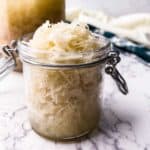Homemade Sauerkraut
Homemade Sauerkraut is rich in probiotics and vitamins, and made with two simple ingredients - cabbage and salt. It is slightly acidic and sour, and full of flavor. One taste and you will never go back to the commercial sauerkraut sold in supermarkets. Sauerkraut is incredibly versatile, and goes with so many things. Try it hot on a reuben, cold on a salad, dressed up with sautéed onions and bacon, or on its own as a refreshing snack. Did I mention that it's super simple to make?
Servings: 12 servings
Calories: 37kcal
Ingredients
- 4 pounds of Cabbage (2 heads) or enough to make 32 ounces shredded
- 2 Tablespoons light grey Celtic sea salt or other unprocessed sea salt, divided (Tip 1)
- 1 ½ to 2 cups filtered water (See Tip 2)
Instructions
- Remove outer leaves from cabbage, retaining 1 leaf.
- Quarter cabbage and remove core. Cut into fine shreds with a sharp knife or food processor (See Tip 3). Add salt to the shredded cabbage. Massage cabbage with hands for several minutes to to begin the process of breaking down the cabbage and the release of brine. Let sit for an hour. Massage cabbage for another 3 to 4 minutes. Then, using potato masher, pound cabbage for 4 minutes.
- Add cabbage to sterilized half-gallon mason jar (See Tip 4). Top cabbage with retained cabbage leaf and weight (See Tip 5). Add enough filtered water to ensure that the liquid level is above the cabbage.
- Place lid with air-lock device on jar. Sauerkraut takes between 3 and 4 weeks to properly ferment. Yield: 2 pounds.
Notes
- Never use salt with additives like iodide, sugar, or anti-caking agents such as calcium silicate. The reason is that they can interfere with the fermentation process. Therefore, stay away from table salt, iodized salt, and Kosher salt. The best salts to use are those that are unprocessed, i.e., salts that still have their complete natural profile of minerals.
- Always use filtered water. The reason is that tap water tends to contain chlorine that can retard the fermentation process.
- My food processor has a variable shredding blade that allows me to cut the cabbage into 1 mm shreds. I've found that 1 mm is the ideal size at least for us.
- I use a canning funnel set on top of the mason jar to more easily add the cabbage to the mason jar.
- I've used different weights through the years such as glass discs, 4 ounce mason jars, and ziploc bags filled with water. The glass discs and mason jars tend to work the best.
Nutrition
Calories: 37kcal | Carbohydrates: 8g | Protein: 1g | Sodium: 560mg | Potassium: 257mg | Fiber: 3g | Sugar: 4g | Vitamin A: 150IU | Vitamin C: 55.4mg | Calcium: 60mg | Iron: 0.7mg
